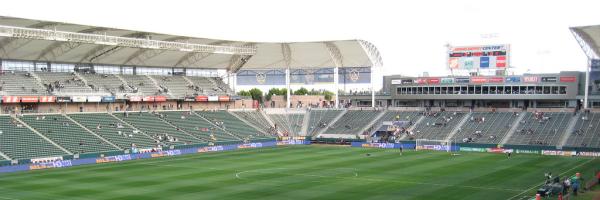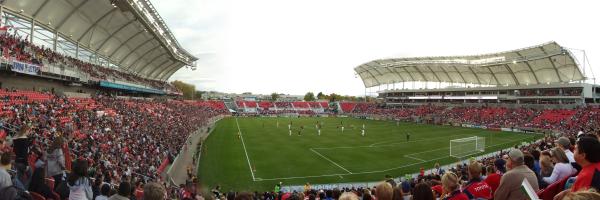
It was only ten years ago that the Major League Soccer seemed to die a slow death. The league was left to only 10 clubs, average attendances were stuck at about 14,000, and several play-off games failed to even attract a crowd of 10,000 fans. And as practically all clubs still played at massive NFL stadiums, this obviously did not make for nice sights.
Now, in 2012, the league seems booming. The way up likely started with the opening of The Home Depot Center, one of the first soccer-specific stadiums in the league and the home of the LA Galaxy. The Galaxy had always attracted reasonable crowds, however 20,000 just looked better in a 27,000 arena than in the massive 90,000 Rose Bowl.
Fair enough, the Columbus Crew had already opened a soccer-specific stadium in 1999, however the stadium looked more like the typical high school American football stadium, whereas The Home Depot Center had many characteristics of a European style football stadium.
The Home Deport Center led the way, and today, with an MLS consisting of 19 teams, the far majority plays in a soccer-specific stadium, a few in a reasonably-sized hybrid suitable for multiple sports, and only two teams, DC United and the New England Revolution, still in an over-sized NFL stadium.
Actually, the Seattle Sounders also play in an NFL stadium (though partly designed for soccer), but one can hardly call it over-sized as the Sounders have attracted 30,000+ crowds since they joined the league in 2009, and almost achieved an average of 40,000 last season.
Whereas the upper tier of Seattle’s CenturyLink Field remained closed before, it may now get opened to the public more often in the new season, as happened during the last match of last season when the Sounders filled the stadium with a crowd of 64,000.
The overall average attendance of the league last season amounted to 17,872, the highest since the start of the MLS, and with recently joined teams from Portland, Vancouver, and Toronto in the upper parts of the table. In comparison with Europe, this puts them just below the Dutch Eredivisie and the French Ligue 1.
This May sees the opening of Houston’s BBVA Compass Stadium, which will have a capacity of 22,000 seats. It will also be the first MLS stadium to be built at a downtown location, with most earlier stadiums built in far-away suburbs.
The San Jose Earthquakes, with last season’s lowest attendances of about 12,000, have just received approval for the construction of a new stadium. A very welcome decision for the club that currently plays at the poor Buck Shaw Stadium.
DC United moves somewhat slower, but is also investigating a move to a soccer-specific stadium. The MLS is furthermore considering expanding the league with another team from New York, which will go accompanied with a newly built soccer-specific stadium.

The latest generation of new MLS stadiums all have a very European look, with a possible highlight the Red Bull Arena of the New York Red Bulls. The earlier generation seemed to suffer somewhat from being designed with high school American football in mind, or with the acoustics of possible music concerts, and sometimes even with a built-in concert stage such as the FC Dallas Stadium.
All signs are there though that the MLS will grow into a mature league, and will again break attendance records this season. It already got off on a splendid start last weekend with sell-outs in Los Angeles, Dallas, Portland and Vancouver, and an average of over 18,000 in the first eight matches of the season. And that did not even include a Seattle home match.
Photo The Home Depot Center: Flickr user Ricardo Diaz.
Photo Rio Tinto Stadium: © Flickr user Scott Catron.